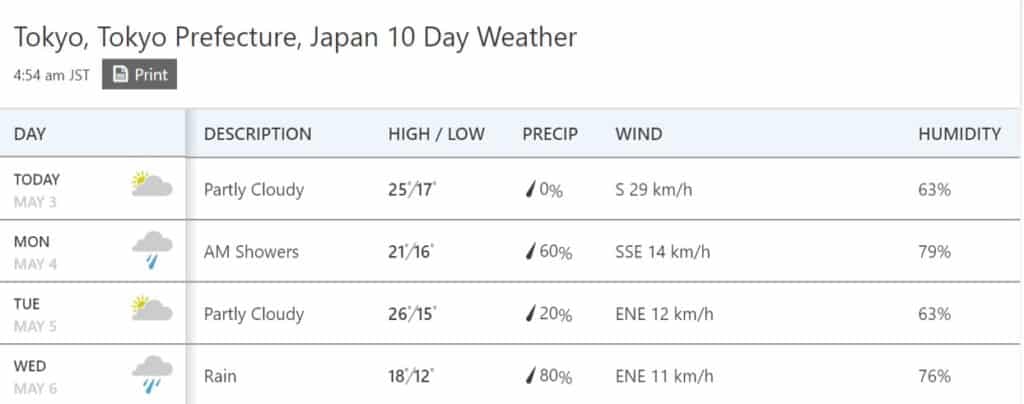It seems the movement to switch America to the metric system has fallen off the wayside in recent years. However, traveling abroad and living overseas, metric conversion is something you need to get used to!
It took a while but now my brain speaks in Celsius and kilometers. Granted, kilometers is an easy jump when you run! I think it still throws some people off when they ask, “how far is your commute to work?” and I reply “about 1.5 km” instead of a little over a mile.
Temperature metric conversion is a bit harder. The earlier you can start getting used to how the numbers work, the better. Especially helpful when checking on weather reports. Knowing what type of clothing to wear is important.
While it can be difficult to get in the habit of thinking in metric, I’ve got some tricks that I hope can help you with metric conversion!
America and the Metric System
Did you know that a Metric Conversion Act was passed in 1975? I honestly have no recollection of ever learning about that in school. Problem is that though it is a law, it’s more of a suggestion.
Further, a law in 1988 amended said Metric Conversion Act to “declare it to be U.S. policy to designate the metric system of measurement as the preferred system of weights and measures for U.S. trade and commerce.”
Still not very strong language if you ask me. But it does add language that all Federal Agencies should use metric wherever practical and I can attest that 15 years into my Federal career (the day job), I’m finally seeing it in practices more often. 40 years after the bill, no big deal.
Further, in 1992, the Fair Packaging and Labeling Act (FPLA) was passed and that is why you see both Imperial (actually it’s technically the US Customary System) and metric on consumer products.
3 Easy Metric Conversion Cheats for American Travelers
While all of this is fine and dandy, it still doesn’t help you in the grand scheme of things when you are used to using Fahrenheit, miles and gallons and then travel to the rest of the world that uses completely different measurement system.
And yes, it is the rest of the world. The United States is one of three countries that hasn’t gotten with the rest of the world and use metric.
For that, here are some quick metric conversion cheats to help you on your trip to Japan or anywhere else for that matter.

1. Celsius to Fahrenheit Rough Calculation
Now, of course, you can type in “Celsius to Fahrenheit conversion” in any search browser and it will pop you up a widget but it’s nice not to have to rely on that. The actual formula is:
°F = 9/5*°C + 32
However, it’s easier just to think of that as doubling the Celsius value (instead of that pesky 9/5ths) and adding 32. To make it simpler yet, you can just add 30 and be in the correct ballpark.
°F= 2*°C + 30
If you need this value for engineering, physics, or chemistry classes like I did, by God, learn the correct formula, but to help out on travel, this will get you there! For instance, on a 20°C day, the real formula will give you 68°F, my cheat way will get you 70°F. Honestly, once you get more comfortable with it, you may find that you just instinctively know the real conversions.
That’s another tip I suggest, know your “limit” temperatures. When do you switch to summer clothes? Winter clothes? Figure out those numbers and know what they are!
2. Convert Miles to Kilometers when you aren’t a runner
Runners typically start out as their first goal past a mile as accomplishing a 5K. 5K = 3.1 miles. If you aren’t a runner though, this might not be something engrained into your mind. This one isn’t as simple as the Celsius formula but if you do some quick math, you can find your result.
Drop the 0.1 off the miles and you’ll be pretty close to the real number. I tend to think in multiples of 5 this way. It’s 10 km? Okay, that’s about 6 miles.
Want to work with smaller numbers? A mile is about 1.6 km.
Another tip for getting in the habit of this, especially since I’ve never seen an American car without both on the speedometers, is to pay attention when you are driving how may kilometers per hour you are going. Then you’ll know that when driving overseas, 80 KPH is about 50 MPH. And yes, that’s what the highways in Japan are, surprisingly low.
Disclosure: Kristenabroad.com is a participant in the Amazon Services LLC Associates Program and other affiliate programs. For some links to products or services in this article, I may earn a small commission by you using my link. The price for you is not affected.
3. Volume Measurements in Metric
The last I’ll touch on is volume. Everyone nowadays seems to have a Nalgene bottle so you probably have a good grasp on what 1 liter looks like. For whatever reason, that has never flopped over well in my head when I go to buy gas in Japan.
A gallon is about 3.8 liters. Or another way to think about it is a liter is about a quarter gallon.
So if you are use to a car needing about 10 gallons of gas to fill up, its nearly 40 liters. So if you are looking to budget your gas, and it’s around 130 yen (or roughly $1.30, the yen swings back and forth to the dollar but you can usually just assume it’s about 1:1 for a cost comparison) it’ll be around $50 USD for a tank.
Becoming Metric Fluent
In the long run, your brain will just instinctively know what 20 degrees Celsius and 10 km translate to and you won’t have to do the calculation anymore. In the meantime, practice a bit and it will go a long way.

